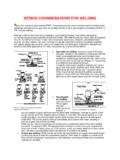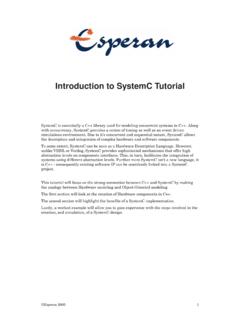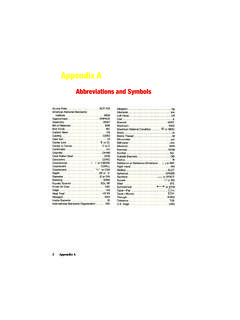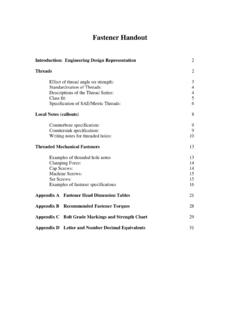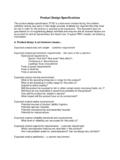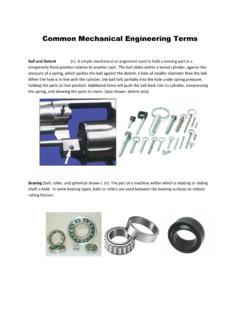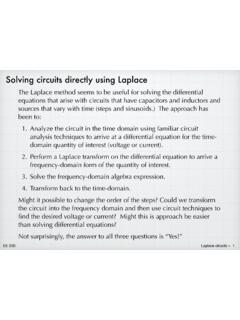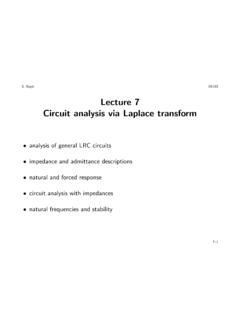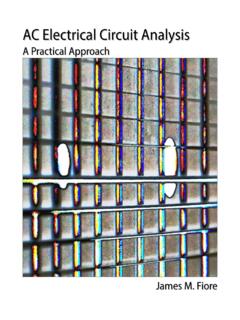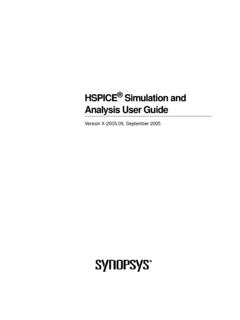Transcription of S-Domain Analysis
1 S-Domain Analysiss- domain circuit AnalysisTime domain (t domain )Complex frequency domain (s domain )LinearCircuitDifferentialequation ClassicaltechniquesResponsewaveformLapla ce TransformInverse TransformAlgebraicequationAlgebraictechn iquesResponsetransformLL-1 Laplace TransformLTransformed CircuitKirchhoff s Laws in s-Domaint domains domainKirchhoff s current law (KCL)Kirchhoff s voltage law (KVL))(1ti)(4ti)(2ti)(3ti0)()()()(4321=+ +titititi0)()()()(4321=+ +sIsIsIsI0)()()(321=++ tvtvtv0)()()(321=++ sVsVsV +)(2tv +)(4tv +)(1tv +)(3tv +)(5tvSignal Sources in s DomainLLt domains domain )(tv_+)(tvS_+)(ticircuiton depends)()()(==titvtvSVoltage Source:_+)(sV)(sVS_+)(sIVoltage Source:circuiton depends)()()(==sIsVsVS+_)(tv)(tiS)(ticir cuiton depends)()()(==tvtitiSCurrent Source:)(sV)(sIS+_)(sICurrent Source:circuiton depends)()()(==sVsVsISTime and S-Domain Element ModelsImpedance and Voltage Source for Initial ConditionsTime DomainLLLs-Domain_+)(tvRR)(tiR)()(tRitvR R=Resistor:_+)(sVRR)(sIR)()(sRIsVRR=Resi stor:_+)(tvLL)(tiLdttdiLtvLL)()(=Inducto r:_+_+)(sVLLs)0(LLi)(sIL)0( )()(LLLLisLsIsV =Inductor:_+)(tvCC)(tiC)0( )(1)(0 CtCCvdiCtv+= Capacitor.
2 _+_+)(sVCCs1svC)0()(sICs)(vsICssVCCC0 )(1)(+=Capacitor:Impedance and Voltage Source for Initial ConditionsRsIsVsZRRR==)()()(0)0(th wi)()()(===LLLLiLssIsVsZ00th wi1)()()(===)(vCssIsVsZCCCC Impedance Z(s)with all initial conditions set to zeroansformcurrent tr transformvoltage)(=sZ Impedance of the three passive elementsTime and S-Domain Element ModelsAdmittance and Current Source for Initial ConditionsTime DomainLLLs-Domain_+)(tvRR)(tiR)(1)(tvRti RR=Resistor:_+)(sVRR)(sIR)(1)(sVRsIRR=Re sistor:_+)(tvLL)(tiLInductor:)0( )(1)(0 LtLLidvLti+= _+)(tvCC)(tiCdttdvCtiCC)()(=Capacitor:In ductor:s)(isVLssILLL0 )(1)(+=_+)(sVLLssiL)0()(sIL)0( )()(CCCCvsCsVsI =Capacitor:_+)(sVCCs1)0(CCv)(sICAdmittan ce and Current Source for Initial ConditionsRsVsIsYRRR1)()()(==0)0(th wi1)()()(===LLLLiLssVsIsY00th wi)()()(===)(vCssVsIsYCCCC Admittance Y(s)with all initial conditions set to zero)(1 transformvoltageansformcurrent tr)(sZsY== Admittance of the three passive elementsExample: Solve for Current Waveform i(t)L_+)(tuVAR)(tiL_+)(sVL)0(LLi +)(sVR_+sVAR)(sILs_+0)()(=++ sVsVsVLRABy KVL:)()(sRIsVR=Resistor:)0()()(LLLisLsIs V =Inductor.
3 0)0()()(= ++ LALisLsIsRIsVLRsiLRsRVsRVLRsiLRssLVsILAA LA+++ =+++=)0()0()()()()0()(tueieRVRVtitLRLtLR AA + = Inverse Transform:forced responsenatural responseSeries Equivalence and Voltage Division)()()()()(1111sIsZsIsZsV==)())() (()()()(2121sIsZsZsVsVsV+=+=KVL:)()()()( )()()()(2211sVsZsZsVsVsZsZsVEQEQ==)()()( )()(2222sIsZsIsZsV==)()()(21sZsZsZEQ+=Re stofCircuitZ1Z2 +)(1sV +)(2sV +)(sV)(sI)(1sI)(2sIRestofCircuitZEQ +)(sV)(sI21 ZZZEQ+=Parallel Equivalence and Current Division)()()(11sVsYsI=)())()(()()()(212 1sVsYsYsIsIsI+=+=KCL:)()()()()()()()(221 1sIsYsYsIsIsYsYsIEQEQ==)()()(22sVsYsI=)( )()(21sYsYsYEQ+=RestofCircuitYEQ +)(sV)(sI21 YYYEQ+=RestofCircuitY1Y2 +)(sV)(sI)(2sI)(1sI)(1sV1 EQZ_+_+Ls)(2sVABEQZ)(1sV_+ABEQZ)(1sV1 EQZ_+_+Ls)(2sVABEQZE xample.
4 Equivalence Impedance and Admittance11)()(21+++=++=+=RCsRLsRLCsRCs RLssZLssZEQEQRRCsCsRsZsYEQEQ11)(1)(11+=+ ==LFind equivalent impedance at A and BSolve for v2(t)Inductor current = 0capacitor voltage = 0at t = 0)(1tvRC_+_+L)(2tvAB)(1sVRCs1_+_+Ls)(2sV AB)(1sV1 EQZ_+_+Ls)(2sVAB)()()()(12112sVRLsRCLsRs VZsZsVEQEQ++==)(1sVRCs1_+_+Ls)(2sVAB1 EQZG eneral Techniques for S-Domain circuit Analysis Node Voltage Analysis (in S-Domain ) Use Kirchhoff s Current Law (KCL) Get equations of node voltages Use current sources for initial conditions Voltage source current source Mesh Current Analysis (in S-Domain ) Use Kirchhoff s Voltage Law (KVL) Get equations of currents in the mesh Use voltage sources for initial conditions Current source voltage source(Works only for Planar circuits)Formulating Node-Voltage EquationsStep 0:Transform the circuit into the s domain using current sources to represent capacitor and inductor initial conditionsStep 1:Select a reference node.
5 Identify a node voltage at each of the non-reference nodes and a current with every element in the circuitStep 2:Write KCL connection constraints in terms of the element currents at the non-reference nodesStep 3:Use the element admittances and the fundamental property of node voltages to express the element currents in terms of the node voltagesStep 4:Substitute the device constraints from Step 3 into the KCL connection constraints from Step 2 and arrange the resulting equations in a standard formExample: Formulating Node-Voltage EquationsL)(tiSRCLt domain )(sISRCs1 Lss domainsiL)0()0(CCv)(sVA)(2sI)(1sI)(3sI)( sVBReferencenodeStep 0:Transform the circuit into the s domain using current sources to represent capacitor and inductor initial conditionsStep 1:Identify N-1=2 node voltages and a current with each elementStep 2:Apply KCL at nodes A and B:0)()()0()0( :B Node0)()()0()( :A Node3121S= ++= sIsIsiCvsIsIsisILCLStep 3.
6 Express element equations in terms of node voltages[][])()()()(1 where)()()()()()(1)()()()(321sCsVsVsYsIR GsGVsVsYsIsVsVLssVsVsYsIBBCAARBABAL===== = =Formulating Node-Voltage Equations (Cont d)Step 2:Apply KCL at nodes A and B:0)()()0()0( :B Node0)()()0()( :A Node3121S= ++= sIsIsiCvsIsIsisILCLStep 3:Express element equations in terms of node voltages[][])()()()(1 where)()()()()()(1)()()()(321sCsVsVsYsIR GsGVsVsYsIsVsVLssVsVsYsIBBCAARBABAL===== = =Step 4:Substitute eqns. in Step 3 into eqns. in Step 2 and collect common terms to yield node-voltage )0()0()(1)(1 :B Node)0()()(1)(1 :A Node+= ++ = +Solving S-Domain circuit Equations circuit Determinant:LsGCsGLCsLsLsCsLsGLsCsLsLsLs Gs++= ++=+ += 22)1()1)(1(1111)(Depends on circuit element parameters: L, C, G=1/R, not on driving force and initial conditions Solve for node A using Cramer s rule:GCsGLCsCvLCsiGCsGLCssILCssLsCsCvsiL ssisIsssVCLSCLLSAA+++ ++++= ++ += =222)0()0()()1()(1)0()0(1)0()()()()(Zero Statewhen initial conditionsources are turned offZero inputwhen input sourcesare turned offSolving S-Domain circuit Eqns.
7 (Cont d) Solve for node B using Cramer s rule:GCsGLCsCvGLsGLiGCsGLCssIsCvsiLssisI LsGsssVCLSCLLSBB+++++++= + += =22)0()1()0()()()0()0(1)0()(1)()()(Zero StateZero inputNetwork Functions Driving-point function relates the voltage and current at a given pair of terminals called a portTransform SignalInput Transform Response state-Zero function Network =)(1)()()(sYsIsVsZ== Transfer function relates an input and response at different ports in the circuit )()(FunctionTransfer Voltage)(12sVsVsTV==Circuitin thezero-state +)(sV)(sICircuitin thezero-state11or IV22or IVInputOutput_+1V +2V)(sTVInOut)()(FunctionTransfer Current )(12sIsIsTI==)()
8 (AdmittanceTransfer )(12sVsIsTY==)()(ImpedanceTransfer )(12sIsVsTZ==_+1V2I)(sTYInOut1I +2V)(sTZInOut1I)(sTIInOut2 ICalculating Network FunctionsZ1Z2 +)(2sV)(1sV_+Y1Y2)(1sI)(2sI)()()(21sZsZs ZEQ+=)()()()()()(21212sZsZsZsVsVsTV+== Driving-point impedance Voltage transfer function:)()()()()(12122sVsZsZsZsV +=)()()(21sYsYsYEQ+=)()()()()()(21212sYs YsYsIsIsTI+== Driving-point admittance Voltage transfer function:)()()()()(12122sYsYsYsYsI +=Impulse Response and Step ResponseT(s) circuit )(sX)(sYInputOutput)( )()(sXsTsY= Input-output relationship in S-Domain )(1)()(sTsTsY= = When input signal is an impulse Impulse response equals network function H(s) = impulse response transform h(t) = impulse response waveformssHssTsG)()()(== When input signal is a step G(s) = step response transform g(t) = step response waveform)()(tutx=)()(ttx =(=) means equal almost everywhere,excludes those points at which g(t)has a discontinuitydttdgthdhsgt)())(( ,)()(0==)


